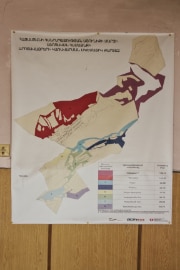
Pasture Management in Armenian Regions
Article, 16.10.2017
The livestock development and keeping in Armenia is heavily dependent on pasture lands. Over the course of recent years, the irregular management and lacking organization of grazing in the rural communities of the country, has resulted in drastic conditions of natural pastures, soil degradation, insufficient fodder base, and threatened the entire biodiversity. Spontaneous livestock keeping has negatively affected the social-economic state of the communities, in a broader sense, the income of the population. Sustainable management procedures for natural pastures are aimed to regulate this issue through strengthening the local authorities’ capacities in Pasture Management.

Ashotavan rural community is located in the south of Armenia, Sisian region, and is one of the target communities of the “Livestock Development in the South of Armenia” project and its component Pasture Management. Armen Beglaryan, 54, the mayor of the Ashotavan community is involved in the project since its very beginning. The mayor Beglaryan is the driving force of the community, who puts his heart and soul in the development of the region. The rotational management of the pasture lands in the community had been an urgent case according to the mayor. Before the start of the project overgrazing and soil degradation were reaching a critical level. “The pastures of Ashotavan community had been considered of a high danger for livestock breeding about ten years ago, not even talking about fodder production and agricultural food production,” says the mayor Beglaryan. However, the years of hard work and improved organization have contributed to the pasture rehabilitation in the community.

The municipality of Ashotavan has developed and introduced practical mechanisms and procedures for the implementation of rotational grazing schemes in a more sustainable way. These procedures involved rights and responsibilities of community authorities and pasture users, sample contracts for pasture users, self-control mechanisms, and more. The management of the project was delegated to the head of the cattle breeding department of the municipality. The group responsible for pasture management after all has been created out of the public, e.g. the big farmers, the village council and the shepherds.

Pasture management tools, such as the “Manual for Monitoring of Pastures”, “Guidelines for Plans Development and Implementation of Sustainable Management plans for Pastures and Grasslands” had been developed in cooperation with the GIZ and provided to the target communities, including Ashotavan community. Entering mayor Beglaryan’s office, the Pastures Monitoring Map is probably the most eye catching object in the room. “The map is constantly being updated to fit the current conditions of the pasture lands of our community,” says the mayor.

This year only, the project resulted in the recovery of 7 to 8 ha of pastures. The population of Ashotavan is highly supportive of the initiative. “ It has taken some time, several years to be exact, for the people to understand the benefits of the sufficient pasture organization, but at this point I think we have got to a success. The degraded soil started to recover,” proudly says Mr. Beglaryan. Currently, about 400 cattle heads are taken to the remote pastures, and the other 130 milking cows are kept at the village.

Sevak Bakunts, 35, is a farmer from Verishen community, located in Syunik region. After finishing his military services, at the age of 20, Sevak decided to become a farmer. The remote pasture, where Sevak takes his 20 cows, is 1500 meters above the sea level, surrounded by the stunning landscape of local mountains. The pasture is built in the framework of the programme, with joint forces of the local municipality and the implementing organization, Strategic Development Agency NGO.

Together with three other farmers, Sevak has a contract for pasture usage, signed with the local municipality. During the high season Sevak milks his cows and transports the milk, 100 to 150 litres daily, to the local milk collection point. Fair half of the month, sometimes even longer, the shepherds and farmers of Verishen community live in the shelter constructed in the remote pasture.

In total, 250 ha overgrazed pastures were rehabilitated, 51 water points, 24.4 km of roads to remote pastures were improved; 3,300 square meters of camping and milking places for cattle. In the result, 19,700 ha of pastures became accessible for over 5,000 farms/households (keeping over 100,000 cattle and small ruminants), which allowed to increase quantity and quality of grass; reduce pressure on overgrazed degraded areas; regenerate productive capacity to achieve sustainable natural resource management at communities level. So far, improved pasture management processes resulted in the enhancement of fodder production system and increased productivity of animal products and consequently, the growth of farmers’ income from cattle breeding.
